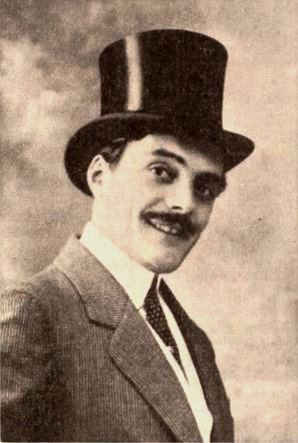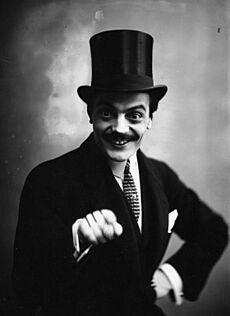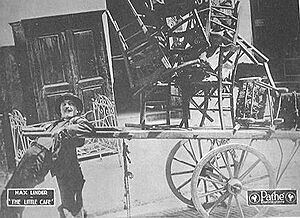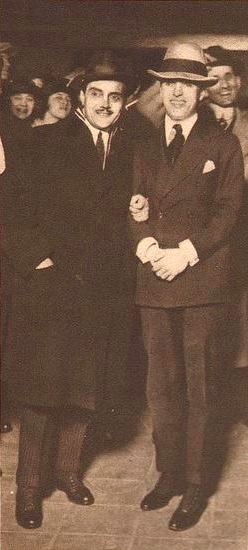Max Linder facts for kids
Quick facts for kids
Max Linder
|
|
|---|---|

Linder in the February 1922 issue of Photoplay
|
|
| Born |
Gabriel Leuvielle
16 December 1883 Cavernes, Saint-Loubès, Gironde, France
|
| Died | 1 November 1925 (aged 41) Paris, France
|
| Occupation | Actor, film director, screenwriter, film producer, comedian |
| Years active | 1899–1925 |
| Spouse(s) |
Hélène "Ninette" Peters
(m. 1923) |
| Children | Maud Linder |
Gabriel Leuvielle (born December 16, 1883 – died November 1, 1925), known as Max Linder, was a famous French actor, director, writer, producer, and comedian. He was a big star during the silent movie era. His character "Max" was one of the first movie characters that people recognized in many different films. Many people called him the "first international movie star."
Max Linder was born in Cavernes, France. He loved theater from a young age. He joined the Conservatoire de Bordeaux in 1899 and won awards for his acting. He worked as an actor in plays by famous writers like Molière and Pierre Corneille.
In 1905, Linder started acting in short comedy films for Pathé. At first, he had small roles. His first main role was in a fantasy film called The Legend of Punching. Over the next few years, Linder made hundreds of short films. In these films, he played "Max," a rich and stylish man who often got into funny trouble. This character became one of the first movie characters to appear in many different comedies. By 1911, Linder was also directing and writing his own films.
Linder joined the army when World War I started. He was a driver and entertainer. He was hurt several times during his service. These experiences affected him a lot, both physically and mentally. Linder later moved to the U.S. but did not find much success there. He passed away in Paris in 1925.
Contents
Max Linder: The First Movie Star
Early Life and Theater Dreams
Max Linder was born Gabriel Leuvielle near Saint-Loubès, France. His family called him "Max" from when he was little. His parents were rich vineyard owners. They wanted Max to take over the family business. His older brother, Maurice, became a famous rugby player. But Max loved theater and was excited by the traveling shows and circuses that visited his town. He once wrote that he really disliked the idea of a life working with grapes.
When Max was a child, he got very sick with cholera. He got better by resting in the village baker's oven. The heat from the oven supposedly helped him recover.
In 1888, a tiny insect called grape phylloxera attacked his family's grape plants. Max's parents thought about moving to America. They went to New York to look for new opportunities. Max and Maurice stayed in France with their grandmother. In the end, his parents decided not to move. They found out that French grapevines could be replaced with stronger American plants that resisted the insects.
While in New York, Max's younger brother, Gérard, was born. Two years after they returned to France, his sister, Marcelle, was born. Max really loved Marcelle. Marcelle, along with his parents, appeared in Max's film Max Is Convalescent (1911). Marcelle also starred with Max in Max, The Heartbreaker (1917).
Starting a Career in Acting
In 1899, Max Linder joined the Conservatoire de Bordeaux, a special acting school. He quickly won top awards for comedy and tragedy. He continued to act in plays and worked at the Bordeaux Théâtre des Arts from 1901 to 1904. He performed in plays by famous writers like Molière and Pierre Corneille.
In 1905, he started using the stage name Max Linder. Around this time, he also began working for Pathé Frères, a film company in Vincennes. He got small roles, mostly in funny slapstick comedies. Max Linder was not a big movie star right away. A popular story says that the film producer Charles Pathé saw Linder on stage. Pathé supposedly wrote him a note saying, "In your eyes lies a fortune. Come and act in front of my cameras, and I will help make it."
Becoming a Silent Film Star (1905–1916)
From 1905 to 1907, Linder acted in many short comedy films for Pathé. He usually played supporting roles. His first bigger role was in The Young Man's First Outing in 1905. He also appeared in fantasy films like Serpentine Dances and The Legend of Punching, which was his first main role.
Max Linder became a star in 1907. Pathé's main comedy actor, René Gréhan, left the company. Gréhan's character, Gontran, wore fancy clothes and acted like a gentleman. Linder was chosen to take over this type of character. This stylish look became his trademark. Film critic David Robinson said Linder's character was "young, handsome, debonair, immaculate...in silk hat, jock coat, cravat, spats, patent shoes, and swagger cane."
Linder made over a hundred short films playing "Max." This character was a rich and stylish man who often got into trouble because he liked beautiful women and a good life. With this character, Max Linder created one of the first movie characters that audiences recognized in many different comedies.
His first film as "Max" was The Skater's Debut in 1907. In this film, "Max" falls around on the ice and does a funny trick with his cane. This was nine years before Charlie Chaplin did a similar trick in his film The Rink. Pathé was not very happy with the film, and it was not popular at first.
Linder's luck changed when Pathé's top comedy star, André Deed, left the company. This made Linder the main comedy actor. In 1909, director Louis Gasnier returned to Pathé and started working with Linder again. They made several short films. They soon found that the "Max" character was the most popular with audiences, so they stuck with him. Some popular "Max" films from this time include A Young Lady Killer and The Cure for Cowardice.
By 1910, Max Linder was becoming one of the most popular film actors in the world. When Gasnier went to the United States, Lucien Nonguet became Linder's director. They made films like Max Takes a Bath and Max Linder's Film Debut. The second film was about Linder's own early film career.
By the end of 1910, Linder was the most popular film actor globally. In Russia, he was voted the most popular actor. He even had a fan in Czar Nicholas II. The first feature film made in Bulgaria was a remake of one of Linder's movies. A Max Linder movie theater opened in Paris.
At the peak of his fame, Linder became very ill with appendicitis. He had to stop making films, and some newspapers even reported that he had died. He got better the next spring and started making films again in May 1911.
In 1911, Linder started co-directing his own films and writing the scripts. By 1912, he was directing his films all by himself. Having full control over his movies made them better and more popular. The films Linder made during this time are often seen as his best. Film critic Jean Mitry called Max, Victim of Quinine his "masterpiece." In this film, "Max" gets into many funny fights with important people.
Silent films could be understood everywhere, which made Linder famous and rich across Europe. He became the highest-paid entertainer of his time. He earned a huge salary of 1 million francs a year. This was a lot of money back then! Charles Pathé used this huge amount to get attention, calling Linder "The Napoleon of the Cinema." This helped set a trend for actors' high salaries in Hollywood.
The best part of Linder's career was from 1912 to 1914. His films were made with great skill, and "Max" was at his funniest. He made films like Max Virtuoso, Max Does Not Speak English, Max and His Dog, and Max's Hat. He worked with actors like Stacia Napierkowska and Gaby Morlay. He also gave a start to young actors like Abel Gance and Maurice Chevalier.
When World War I began in 1914, Linder's film career paused. He made a patriotic film called The Second of August. Linder tried to join the French army, but he was not fit for fighting. Instead, he worked as a driver, delivering messages between Paris and the front lines. There are different stories about why he left the army. Some say he was badly hurt. One newspaper even reported he was killed, but Linder called them to say he was alive! Others say he got sick after hiding in icy water. After leaving his duties, Linder spent the rest of the war entertaining soldiers and making films. During this time, Linder also started to suffer from chronic depression.
Moving to the U.S. and Later Career (1916–1925)
In 1916, an American film producer named George K. Spoor asked Linder to make twelve short films in the U.S. He offered Linder $5,000 a week. Earlier that year, Charlie Chaplin, who was the most popular comedian, had left Spoor's company. Spoor wanted Linder to replace Chaplin. Linder accepted the offer and moved to the United States.
Sadly, his first few American "Max" films were not popular. The first two, Max Comes Across and Max Wants a Divorce, did not do well. The third film, Max and his Taxi, was a bit more successful. The film studio was having money problems and stopped making the rest of Linder's films. While in Hollywood, Linder became good friends with Charlie Chaplin. They often went to events together and talked about their film ideas. Linder said Chaplin's suggestions were very helpful.
Linder went back to France in 1917 and opened a movie theater called Ciné Max Linder. Because of his depression and worries about the war, he could not make films regularly. After the war ended in 1918, Linder felt better and agreed to make a feature film called The Little Café in 1919. In this film, Linder plays a waiter who suddenly becomes a millionaire. But he is tricked into a twenty-year contract to keep working as a waiter. The film earned a lot of money in Europe and helped his career for a short time, but it did not do well in the U.S.
Four years later, Linder tried again to become a big star in the U.S. He started his own film company in Hollywood in 1921. His first film back in the U.S. was Seven Years Bad Luck. Some people think this is his best film. It has one of the earliest examples of the "human mirror" trick, which was later made famous by the Marx Brothers in Duck Soup. Linder then made Be My Wife later that year. But again, neither film found a large audience in the U.S.
Linder then decided to try something different for his third and final American film: The Three Must-Get-Theres in 1922. This film made fun of adventure films starring Douglas Fairbanks. It was loosely based on the story of Alexander Dumas' The Three Musketeers. Both Fairbanks and Charlie Chaplin praised the film, but it did not do well at the box office. At the film's premiere, Linder told director Robert Florey, "I sense that I'm no longer funny... The public is mildly amused by my situations, but... I don't feel funny anymore."
With his depression making it hard to work, Linder returned to France in 1922. Soon after, he made a serious film with some comedy called Au Secours! (Help!) for director Abel Gance. This film is a horror film set in a haunted house. The film was praised in England in 1924. Linder's last film was The King of the Circus, filmed in Vienna in 1925. In this film, "Max" joins a circus to be closer to the woman he loves. The film has funny parts, like a hungover "Max" waking up in a department store. Its story is similar to Charlie Chaplin's film The Circus (1928). In late 1925, Linder was planning his next film, Barkas le fol, but it was never made.
Personal Life and Passing
Because of his time in the war, Linder had ongoing health problems. He suffered from severe depression and had several mental breakdowns. People who worked with him said he seemed "unstable" and "worried."
During his war service, Linder was in a car accident. He was thrown from the car and badly hurt.
In April 1923, Linder was in another serious car accident in Nice, which caused a head injury. Later that month, he was arrested in Nice for "kidnapping a minor." This "minor" was his future wife, Hélène "Ninette" Peters, who was seventeen. They had planned to run away together.
When Linder and Peters first met, he was very taken with her. He told a friend, "I spent the whole night in a hotel lounge talking to the most extraordinary girl I could ever imagine. Instantly I knew this to be the woman in my life." They got married on August 2, 1923, in Paris. They lived in an apartment in Paris.
In late October 1925, Linder and his wife were both found unconscious. Peters passed away first. Linder remained unconscious through October 31. Doctors tried to save him, but he passed away after midnight on November 1.
Max Linder was buried in the Catholic cemetery of Saint-Loubès. His wife is buried in Père Lachaise Cemetery in Paris.
Max Linder's Lasting Impact
When Charlie Chaplin heard about Linder's death, he reportedly closed his studio for a day to show his respect.
Over the years, many of Linder's films were lost. Max Linder was almost forgotten in film history. But then, a film called Laugh with Max Linder was shown at the Venice Film Festival. This film was a collection of Linder's last three movies made in Hollywood. Linder's daughter, Maud Linder, helped bring this film to audiences.
In 1983, Maud Linder made a documentary film about her father's life called The Man in the Silk Hat. It was shown at the 1983 Cannes Film Festival. In 1992, Maud Linder wrote a book in France titled Max Linder was my father. In 2008, she received an award for her work to keep her father's memory alive. A public school in Libourne, France, near his birthplace, was named Lycée Max Linder in his honor in 1981.
Max Linder had a big impact on film comedy, especially on slapstick films. He helped change comedy from wild "knockabout" styles to more subtle, character-focused humor. This style was later used by comedians like Chaplin, Buster Keaton, and Harold Lloyd. Chaplin himself was influenced by Linder. Chaplin even sent Linder a signed photo that said: "To Max, the Professor, from his disciple, Charlie Chaplin." Other famous directors like Mack Sennett and King Vidor also said Linder influenced their work. His stylish "Max" character also influenced actors like Adolphe Menjou.
In his most famous years, Linder had two main rivals in France: Léonce Perret and Charles Prince. Perret later became a successful director. Charles Prince, known as "Rigadin," was also a popular comedian. Like "Max," Rigadin was a clumsy, rich socialite who often got into trouble. Both Linder and Prince worked for Pathé in the early 1910s and sometimes used similar stories and directors. Years after their careers ended, Max Linder has seen a renewed interest, while Charles Prince is mostly forgotten.
Max Linder in Pop Culture
Max Linder is mentioned in Quentin Tarantino's movie Inglourious Basterds. In the film, a cinema owner in Paris plans to have a Max Linder film festival. A German soldier then discusses if Linder is better than Chaplin. He argues that Linder is superior but admits Linder never made anything as good as The Kid.
The documentary film The Mystery of the King of Kinema shows Linder's life and impact. It includes interviews with Maud Linder and uses clips from his silent films.
Selected Films
- 1905 The Legend of Punching
- 1907 The Skater's Debut
- 1909 A Young Lady Killer
- 1909 Max And The Lady Doctor
- 1909 The Cure for Cowardice
- 1910 Max Goes Skiing
- 1910 Max Takes a Bath
- 1910 Max Linder's Film Debut (Les Debuts de Max au Cinema)
- 1911 Max en Convalescence
- 1911 Max, Victim of Quinine
- 1911 Max and His Mother-in-Law
- 1911 Max Takes Tonics
- 1911 Max Prends un Bain (Max takes a Bath)
- 1912 A Farm-House Romance
- 1912 Max Lance La Mode
- 1912 Max and His Dog
- 1912 L'Amour Tenace
- 1912 Max a Peux de l'Eau (Max is Scared of the Water)
- 1912 Max et Jane veulant faire du Theatre
- 1912 The Romance of Max
- 1912 Une nuit agitée (An Agitated Night AKA Max in One Exciting Night)
- 1912 A Waterplane Elopement
- 1912 Entente Cordiale
- 1913 Max's Hat
- 1913 Max Takes a Picture
- 1913 Max's First Job
- 1913 Max Virtuoso
- 1913 Les Vacance de Max
- 1913 Max Pedicure
- 1914 Max Does Not Speak English
- 1914 Max and the Jealous Husband
- 1914 The Second of August
- 1914 Max and His Mother-in-Law (Max et sa Belle-Mere)
- 1916 Max and the Clutching Hand
- 1917 Max Comes Across
- 1917 Max Wants a Divorce
- 1917 Max and His Taxi
- 1919 The Little Cafe
- 1921 Seven Years Bad Luck
- 1921 Be My Wife
- 1922 The Three Must-Get-Theres
- 1924 Au Secours!
- 1925 The King of the Circus
- The Porter from Maxim's (1927, screenplay)
See also
 In Spanish: Max Linder para niños
In Spanish: Max Linder para niños






